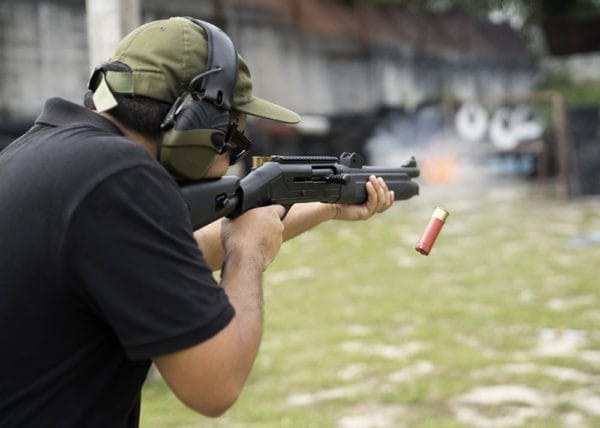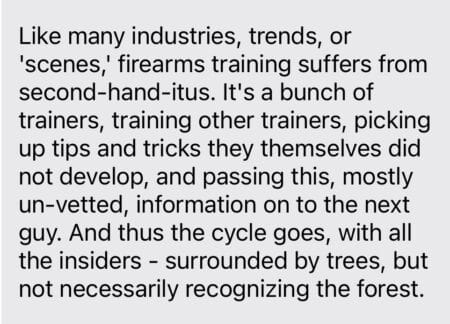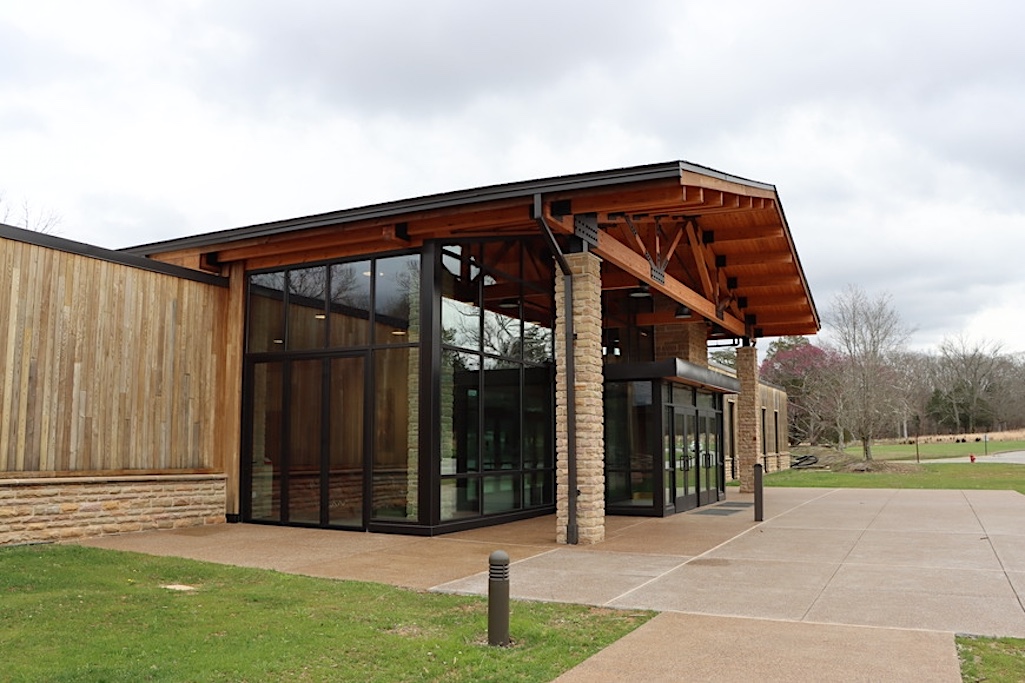
Disciplines matter! You must understand that there exists a variety of disciplines within the world of firearms training, and not all of these firearms training disciplines are the same. First off, there are a few facts I need you to be aware of.
FIRST FACT: As stated above, there are multiple disciplines within the firearms training and shooting world. Each discipline is unique unto itself. Sometimes the ‘colors’ (techniques and/or procedures) bleed or blend from one discipline into another, and sometimes they are polar opposites. Irrespective of any carryovers that exist, context absolutely matters.
SECOND FACT: Engaging in motor skill, psychomotor skill, and motor learning development training and continuing training to further develop proficiency (and then mastery) in one discipline does not mean that one is fully and adequately prepared to engage in any other discipline. Moreover, extensive scientific research has established that even the development of mastery-level motor skills and psychomotor skills in one technique within a single discipline does not equate to mastery of all techniques within that discipline, including those that are functionally, mechanically, and kinesiologically similar.
WHAT ARE THESE DISCIPLINES?
There are five primary categories that I would choose to outline in this section. These categories, in no particular order, are:
- Target, sport, recreational, and hunting
- Competition
- Combat (military)
- Duty (law enforcement and private/contract security)
- Self-defense and home defense
TARGET, SPORT, RECREATIONAL, AND HUNTING
This is the catch-all category. The target, sport, recreational, and hunting category, as I see it, is probably the largest category, and also serves as the catch-all category. This would include range shooting, target shooting, plinking, hunting, and any other type of firearms activities or shooting done for recreational purposes. I don’t think this category requires a lot of further elaboration. I think the name pretty much says it all. Target, sport, recreational, and hunting activities.
Formal training opportunities in these activities, such as the beginner NRA and USCCA-type programs, emphasize a very basic, rudimentary familiarization of simple marksmanship concepts (grip, stance, sight alignment, sight picture, etc.) and there remain extremely limited standardized methodologies of testing and assessing even the most basic of motor skills outside of simply looking at a shot grouping. “Instructors” in this discipline, more often than not, choose not to engage in ANY continuing education opportunities. Many of these individuals treat firearms “instruction” as a money-making ‘side hustle,’ and many who claim the ability to “teach” the most basic of skills largely remain unable to demonstrate or perform to even the most basic of standards themselves. Here, money spent is money wasted. Period. “Those who cannot do… teach” is a mantra that, unfortunately (and sadly) absolutely rings true in this discipline.
(Note 1: This is not intended to be a sweeping indictment of every instructor in this discipline. There are some OUTSTANDING instructors existing in this discipline who understand the limitations of their experience, limitations of their capabilities, and limitations of their credentialing. Unfortunately, they are few and far between, and tend to be overshadowed and drowned out by the “loudest” of the bunch. And far too often, the ones making the most “noise” are the very ones you’d want to avoid.)
[Note 2: ALWAYS ask to see credentials when seeking out professional instruction. Ask about (and demand proof of) continuing education within the firearms world.]
COMPETITION
While some would choose to lump competitive shooting in with the previous category, given that it is largely recreational, I believe it is far more appropriate to classify competitive shooting in its own category.
The term “competition shooting” covers an extensive array of specialized shooting activities, many of which involve proficiency tests of speed along with accuracy and precision of shot placement, and others also include reloading and stoppage-clearance drills (heavily rehearsed basic motor skill sequences) following a predetermined auditory stimulus (buzzer, whistle, or verbal “Fire!” command.) These competitions take place in a pre-familiarized and controlled environment that establishes a foremost focus on safety, with many providing little-to-no opportunity for tactically based, recognition-primed (adaptive) critical decision-making. Moreover, competitive performance has little to no discernible correlation to actual, statistical gunfighting performance metrics. Depending on the type of competition, participants will often compete with pistols, revolvers, rifles, and shotguns that are often significantly enhanced with specialized equipment or with heavy structural and/or mechanical modifications designed to dramatically increase speed and accuracy. These firearms would likely be impractical to carry as personal defense weapons and would largely be prohibited for professional duty carry (law enforcement and security personnel) by employing agency policies that most often require standardization (and court-defensibility) of not only firearms but of other use-of-force tools.
Examples of these competitive shooting activities include (but certainly are not limited to):
- Trap, skeet, and sporting clay shotgun competitions
- Cowboy and bullseye pistol and revolver shooting
- Steel Challenge pistol shooting
- United States Practical Shooting Organization (USPSA)
- International Defensive Pistol Association (IDPA)
COMBAT (MILITARY)
This category encompasses members of our American armed forces, including National Guard units.
Members of the armed services receive training based upon the expectation that at some point in time, they may be called upon to fight in a war or military conflict, provide security services abroad or domestically during critical or mass casualty incidents, provide security services, humanitarian assistance, or peace-keeping operations abroad or domestically. An important factor to keep in mind is that since many of these operations are being conducted on foreign soil, the rules of engagement individuals are expected to operate within are oftentimes drastically different than those rules that one would expect to operate under domestically.
The vast majority of operators within this discipline undergo very basic familiarization with a limited number of basic weapon systems during initial training periods and are subsequently tested to extremely low minimum standards of adequacy, with extensive degradation of associated skill sets as months and years elapse. (Clinical research has documented the negative effects of time as it relates to the degradation of both motor skill performance capacity and non-consolidated semantic (declarative) memory. (Gardlin, Sitterley 1972; Northrup 2019; O’Neill et al. 2019)³
The overwhelming majority of these individuals, while having previously been familiarized with basic weapons systems, move on to engage in occupational specialties that do not involve or require the carrying or use of firearms at all, in any capacity. The obvious exception to this would be those individuals who fall under the “combat arms” classification. (The standard, ‘accepted’ percentage of “trigger-pullers” is 10% of all military personnel.)
DUTY (LAW ENFORCEMENT AND PRIVATE/CONTRACT SECURITY)
The category of duty or professional gun carriers encompasses individuals who are required to, as a routine and standard part of their occupation, carry firearms. This does not mean, nor should it be construed to mean, that these people are experts in the manipulation or handling of firearms or the decision-making skills required in non-linear, dynamic, use-of-deadly-force scenarios.
Those included in this category would include federal, state, and local law enforcement officers, corrections officers, constables, court officers and bailiffs, security officers, armored car drivers, private investigators, and in some states, bail enforcement officers. Keep in mind that this is not an all-inclusive list, so no offense is intended if I’ve left someone out.
Individuals employed in these capacities are generally required to carry firearms to stop imminent threats of death or great bodily harm to themselves or other persons in their immediate vicinity, prevent the imminent commission of forcible felonies, and, in the case specifically of law enforcement officers, to stop or prevent the escape or “flight” of a felon from custody.
As I noted in the military/combat category above, the vast majority of operators within the duty category undergo, in a very similar fashion, very basic familiarization with a limited number of basic weapon systems during short initial training periods and are subsequently tested to extremely low, non-contextually-relevant minimum standards of adequacy (often a minimum passing score of seventy-five percent [75%]) using a series of pre-learned, pre-planned, and pre-rehearsed basic motor skill sequences following a pre-familiarized auditory stimulus (buzzer, whistle, or verbal “FIRE!” command) on a static, pre-familiarized, and controlled environment which has a foremost focus on safety, with little-to-no opportunity for tactically-based, critical decision making. Moreover, standardized qualification performance has little to no discernible correlation to actual, statistical gunfighting performance metrics. Once the candidate has successfully passed this test involving minimum adequacy standards, those associated basic motor skill sets will experience extensive degradation as time expands. (Again, as I noted above, clinical research has documented the effects of time as it relates to the degradation of both motor skill performance capacity and dormant or infrequently accessed semantic (declarative) memory.)
As a matter of fact, you should be aware that the overwhelming majority of states require less training (in hours) to become a certified police officer (as little as four hundred eight [408] hours in Georgia) than the EIGHT HUNDRED (800) hours of training that the retail establishment PetSmart requires of its pet groomers. In academy settings, firearms training accounts for as little as forty (40) hours or one week of the total number of academic hours.
In many states, armed security officers, armored car drivers, and bodyguards are not required to obtain licensure prior to engaging in these activities. Moreover, some states do not require any training or proficiency examinations/qualifications with firearms, while others require as little as four (4) hours per year.
Take it from someone who has literally spent an entire career training and remediating people in government and law enforcement sectors… fifty percent of them couldn’t hit water if they fell out of a boat, let alone ‘ace’ a qualification. The thought of that should, rightfully, terrify you.
SELF-DEFENSE & HOME DEFENSE
The last category involves the training with, as well as the ownership, carrying, and usage of firearms for the purposes of personal protection as well as protection of the home.
As it relates to the training of tactics, techniques, and methodologies pertaining to the use of deadly force for personal protection purposes, the state of the training industry leaves a lot to be desired.
During a recent text conversation with an instructor-student of mine (we’ll call him “Alex,”) he reflected as follows:


I couldn’t agree more.
Over the past several years, I’ve seen a dramatic uptick in the number of instructors offering everything from “tactical training” to “residential clearing and defensive shooting instruction” to “active shooter response training” and “church security training” on NRA and USCCA instructor ‘credentials.’
Picking this specific discipline apart would require at least another article or two, so to keep this article within word count parameters, I will have to devote a future article to the dissection and analysis of this topic.
- Note 1: As I stated previously, this is not intended to be a sweeping indictment of every instructor in this discipline. There are some OUTSTANDING instructors that exist in this discipline who understand the limitations of their experience, limitations of their capabilities, and limitations of their credentialing.
- Note 2: ALWAYS ask to see credentials when seeking out professional instruction. Ask about (and demand proof of) continuing education within the firearms world.
It is important to note at this point that each state has differing laws that relate to the use of firearms for personal protection, as well as the defense of one’s home. Some states are very permissive and favor the responsible armed citizen, while others are extremely restrictive and certainly appear to favor the criminal over those who obey the law. At this point, I would be remiss if I didn’t state (emphatically) for the record that you MUST seek out proper legal education regarding the laws of your respective state. Never assume anything when it comes to gun laws, self-defense laws, or use-of-force laws. A great place to start your legal research is the website handgunlaw.us. This website serves as an excellent online resource that is constantly being revised and updated. It can provide you with an outstanding and concise overview of the laws of each state on essential topics like concealed weapons license requirements, whether or not you reside in a state that has a legal “duty to inform,” places where carrying a firearm may be legally off limits and also overviews on use of force laws, stand your ground laws, castle doctrine laws, and much more.
Moreover, when it comes specifically to the specificities and nuances of self-defense law, I wouldn’t take the opinion or advice of an NRA or USCCA instructor, a CCW instructor at the local gun shop or gun range, or my Krav Maga coach. [Much more on this in a later article.] Nor would I take the opinion of the local beat cop or patrol officer I may know from my child’s Little League games or the local pastry shop. Unless they are specifically involved in police-level firearms training (or any other field that deals with what’s known as “high-liability training”) or happen to be an investigator dealing with firearms and use-of-force crimes, and further are familiar with not only the statutes or laws of the state but also the legal precedents that have formed as a result of the various courts’ interpretation and application of those statues or laws, then they’re most assuredly NOT subject matter experts and are in no way qualified to provide legal opinions.
It is necessary to state for the record that I am NOT in favor of requiring law-abiding citizens to assume the bended-knee position and play the “mother may I?” role in front of a government bureaucrat in order to exercise their Second Amendment right. I believe in Constitutional carry, and I am proud to live in a state that has codified Constitutional carry.
For those who do not enjoy this luxury, you have the choice of (a) moving to one of (as of this writing) twenty-nine states that recognize Constitutional carry or (b) playing the licensing game with the remaining twenty-one states that somehow believe that they have the power and right to circumvent the Constitution. Irrespective of your position, you owe it to those who occupy the public spaces you share to get the absolute best training you can, understand the laws respective to any use-of-force application, understand and role-model the non-negotiable rules of safe gun handling, and exemplify what it means to be a law-abiding firearms owner.
About Keith Hanson
Keith Hanson is a seasoned law enforcement professional specializing in firearms instruction, tactical operations training, and counterterrorism tactics. With a strong background in neuroscience and psychology, Keith is a co-creator of the innovative NeuralTac™ system. This methodology combines neuroscience, combat psychology, neuropsychology, kinesiology, and educational sciences, drawing from the latest research in human performance, to produce advanced instructional programs for law enforcement agencies and private security firms. It also aims to develop and foster advanced-level master trainers within those organizations. Additionally, as a certified force science analyst, Keith serves as a court-recognized expert witness on use of force matters and provides consultation on legal strategies.
X (Twitter): @theguncoach






